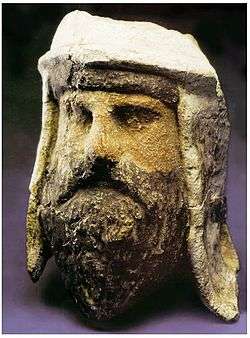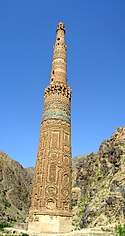Takhti-Sangin

Painted clay and alabaster head, Takhti-Sangin, Tajikistan, 3rd-2nd century BC.
The ancient town of Takht-i Sangin is located near the confluence of the Vakhsh and Panj rivers, the source of the Amu Darya, in southern Tajikistan.
Site description
The Greco-Bactrian temple site of Takht-i Sangin is believed by many to be the source of the Oxus Treasure[1] that now resides in the Victoria and Albert Museum and British Museum. Part of greater Transoxiana and built in the 3rd Century BC, the site consists of a well-fortified citadel containing the so-called "Temple of Oxus".[2]
World Heritage Status
This site was added to the UNESCO World Heritage Tentative List on November 9, 1999 in the Cultural category.[2]
Notes
- ↑ Holt, F.L. (1989) p 43
- 1 2 The Site of Ancient Town of Takhti-Sangin - UNESCO World Heritage Centre
References
- The Site of Ancient Town of Takhti-Sangin - UNESCO World Heritage Centre Retrieved 2009-03-04.
- Holt, F.L. (1989), Alexander the Great and Bactria: The Formation of a Greek Frontier in Central Asia: 2nd Edition, Brill Archive. ISBN 90-04-08612-9
This article is issued from
Wikipedia.
The text is licensed under Creative Commons - Attribution - Sharealike.
Additional terms may apply for the media files.
